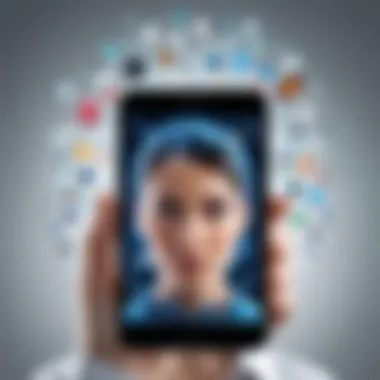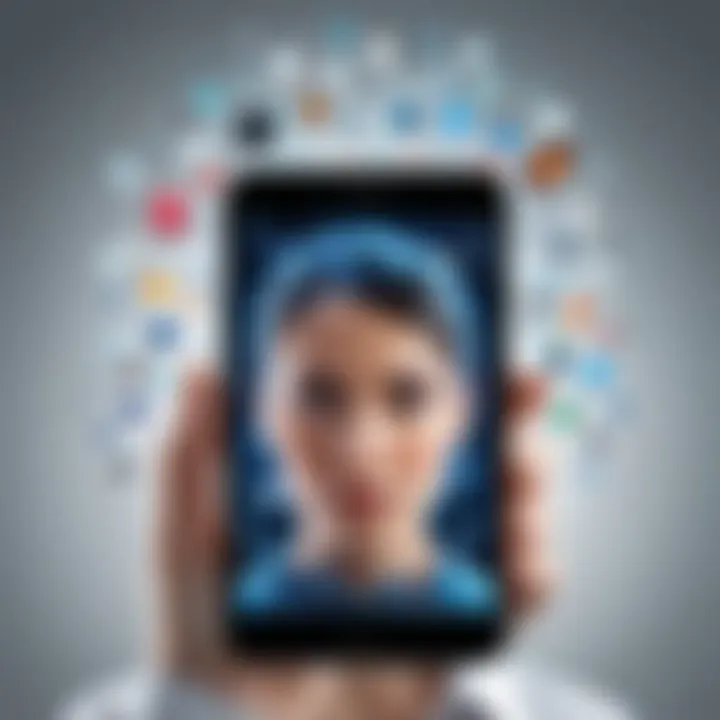Understanding Cell Phone Addiction: Impacts and Solutions


Intro
In a world that's increasingly tethered to screens, cell phone addiction has become a hot-button issue. With the rapid advancement of technology, we find ourselves intertwined with these devices to an extent that begs the question—are they serving us, or are we serving them? The incessant dopamine hits from notifications create a loop that's hard to break.
This article aims to peel back the layers on this complex phenomenon, exploring everything from its definition to the deeper implications on our mental health, relationships, and society at large.
As we dive into the causes and symptoms of this addiction, we also confront the psychological effects it imposes on both individuals and communities. Armed with this understanding, we will look at strategies that can mitigate its impact, catering to our collective duty to foster healthier interactions with our devices.
Whether you're a technology enthusiast, a casual phone user, or simply someone curious about human behaviour in the digital age, the insights provided here will be both profound and practical.
Defining Cell Phone Addiction
Defining cell phone addiction is crucial in comprehending the various dimensions and implications of excessive mobile phone use in today's tech-centered world. As we delve into this topic, it becomes clear that cell phone addiction isn't just about the amount of time spent on devices; it's about the profound impact it has on individuals' lives, relationships, and overall well-being.
Beyond mere definitions, it's vital to understand the specific elements that characterize this condition. Behavioral addiction, similar in nature to gambling or substance abuse, reveals itself through compulsive use, inability to regulate usage, and emotional disturbances linked to device interaction. Recognizing these factors helps in identifying the need for interventions and support mechanisms to address this pervasive issue.
Understanding Behavioral Addiction
Behavioral addiction encompasses various compulsive behaviors that are harmful to the individual and their surroundings. With the rise of smartphones, cell phone addiction can be classified as a behavioral addiction. It mirrors traditional addictions in terms of the neurological pathways it involves, particularly where dopamine plays a key role. When users engage with their phones—be it through notifications, social media, or gaming—the brain releases dopamine, leading to pleasure and a compulsion for continued interaction. This cycle can create a dependency that is challenging to break.
Another layer to consider is the impact of design choices made by tech companies. Many applications are intentionally designed to be engaging, encouraging users to interact for as long as possible. For example, social media platforms such as Facebook and Reddit utilize features designed to capture attention and keep users returning for more.
Criteria for Diagnosis
When it comes to diagnosing cell phone addiction, criteria can vary significantly, but they often align with established behavioral addiction parameters. Here are key points to consider:
- Excessive use: Individuals may find themselves using their phones for extended periods, often at the expense of daily tasks or responsibilities.
- Withdrawal symptoms: Experiencing anxiety or irritability when separated from their device can be a strong indicator.
- Loss of control: Individuals may struggle to limit their usage despite knowingly facing negative consequences.
- Neglecting relationships: A persistent focus on mobile interactions can lead to deteriorating personal relationships.
By understanding these criteria, we can recognize the importance of addressing cell phone addiction not just as a personal struggle, but as a matter that effects societal norms and health. A clear definition does not only help in diagnosing individuals but lays the groundwork for effective preventive measures and solutions to mitigate further impacts.
Prevalence of Cell Phone Addiction
The issue of cell phone addiction isn't just a trivial matter; it’s increasingly being recognized as a significant societal dilemma. The prevalence of this problem sheds light on its widespread consequences on various demographics and offers crucial insights into the underlying patterns of behavior associated with excessive phone use. Understanding how rampant this addiction is can guide interventions and preventive measures that may be necessary to combat the habitual overuse of mobile devices.
Global Statistics
If we take a look at the world stage, several studies have revealed alarming statistics surrounding cell phone addiction. According to a survey conducted by the Pew Research Center, around 81% of Americans own a smartphone. This extensive penetration suggests that these devices have become almost an extension of ourselves. Studies indicate that, on average, individuals spend about 3 to 5 hours a day glued to their screens. When you multiply that by days, weeks, and months, it’s clear that these devices are altering our lives in ways we may not even notice.
Moreover, a report from the International Telecommunication Union states that more than 90% of the world’s population lives within reach of a mobile signal. This access facilitates constant connectivity, but it also heightens the risk of addictive behaviors. Countries like South Korea have reported about 57% of teenagers displaying symptoms of addiction, illustrating how young people are at a greater risk. Countries with burgeoning tech markets are experiencing even more significant upticks in addiction rates due to the rapid increase in smartphone usage.
Statistics like these make it evident that cell phone addiction is not confined to specific regions or cultures; it’s a global issue impacting communities and families all around.
Demographic Insights
Delving deeper into demographics reveals differing impacts of cell phone addiction across age groups, gender, and socioeconomic status. Research has shown that teenagers, aged 13 to 19, are among the most affected, often spending upwards of 7 or 8 hours a day on their devices. This age group frequently turns to social media platforms like Facebook and Reddit, fostering a sense of belonging but also promoting addictive tendencies.
Interestingly, gender also plays a role. Studies suggest that women tend to exhibit more emotional attachment to their smartphones, often leading to compulsive checking behaviors. On the contrary, men may engage more with gaming applications, contributing to usage patterns driven by competition and achievement.
The socioeconomic aspect cannot be ignored either; individuals from lower-income backgrounds often rely heavily on smartphones for communication, education, and job searching. Consequently, their dependence may become entangled in economic pressures that exacerbate addiction, creating a cycle that is hard to break.
In summary, the prevalence of cell phone addiction manifests not only in sheer numbers but also in its diverse implications across various sections of the population. These insights form the bedrock of understanding why this addiction must be addressed both individually and collectively as a society.
Causes of Cell Phone Addiction
Understanding the causes of cell phone addiction is crucial to figuring out solutions for it. Grasping why people get hooked on their devices can open doors to effective strategies to curb this growing concern. From the psychological ties that bind us to our screens, to the societal expectations that seem to hold us hostage, these causes often overlap and feed into one another. It's like a web that’s difficult to untangle.
Technological Factors
At the heart of cell phone addiction are the advanced technologies that captivate users. These devices aren't just tools anymore; they have become extensions of ourselves. The design features are meant to maximize engagement. For instance,
- Notifications: Every ding or buzz sparks curiosity. They are like a siren call, pulling us away from the real world.
- Social Media Platforms: Platforms like Facebook and Instagram are designed to be addictive. Scrolling through feeds can be a rabbit hole that is hard to climb out of. The continuous updates keep users glued to their screens for hours.
Moreover, the allure of instant gratification plays a big role. Users often seek quick hits of dopamine with likes and messages, creating a cycle that can be hard to break. As devices become smarter, with features tailored to keep us engaged, it’s no wonder that many find it hard to detach.
Psychosocial Influences
We can't look at cell phone addiction without mentioning the social dynamics at play. The need for connection in a digital age can turn healthy interaction into dependency. Peer pressure can make individuals feel as though they constantly need to check their phones to stay in the loop. Here are some psychosocial elements that influence this addiction:
- Fear of Missing Out (FOMO): This phenomenon is common among younger demographics. The constant need to be updated can lead to compulsive checking of messages and social media apps.
- Validation Seeking: Many derive self-worth from online interactions. The need for likes and comments reinforces behavior, creating a cycle that reinforces the use of devices.
- Isolation from Real-Life Interaction: As more people spend time online, real-world interactions suffer. This sometimes leads individuals to resort to their phones to feel connected, further complicating the addiction.


Cultural Context
Cultural shifts have significantly influenced how we interact with technology. It’s now common to see groups of friends sitting together, each absorbed in their phones. The normalcy of this behavior sends a clear message: constant connectivity is expected. Several aspects contribute to this:- Tech as Status: In many cultures, having the latest devices is not just about functionality but also about status. This creates pressure to stay updated, resulting in increased reliance on phones.
- Workplace Expectations: As remote work and constant communication become norms, professionals feel compelled to carry their devices everywhere. The blending of personal and professional spaces often blurs the lines, making it increasingly difficult to step away.
- 24/7 Availability: The expectation that one should be reachable at all times can create anxiety. This pressure can lead to compulsive checking of notifications, even during personal time.
Understanding these causes provides the groundwork for addressing cell phone addiction. It is essential to find balance in the use of technology and recognize the broader implications of our device dependencies.
In summary, recognizing the multifaceted causes of cell phone addiction is not just a matter of pinpointing problems. It's about understanding how intertwined our lives have become with technology, society, and culture. Tackling this issue demands a complete picture, allowing for targeted interventions that can lead to healthier habits.
Symptoms of Cell Phone Addiction
Identifying the symptoms of cell phone addiction is pivotal for recognizing the magnitude of the issue. Understanding how excessive phone use manifests can help individuals, families, and communities to address the problem head-on. The symptoms can range from physical to emotional and social indicators, each revealing the toll that constant connectivity may have on an individual’s life. Recognizing these symptoms allows for proactive measures that can be implemented both personally and within larger social frameworks.
Physical Symptoms
The physical manifestations of cell phone addiction are often overlooked but can be pernicious. Users may experience notable issues such as:
- Eye Strain: Staring at screens for hours can lead to digital eye strain, commonly presenting as dryness, glare sensitivity, and blurred vision. The blue light emitted from screens may disrupt sleep patterns as well.
- Neck and Back Pain: Poor posture while using mobile devices can lead to what’s often referred to as "text neck." This condition not only causes discomfort but can also have long-term health implications if left unchecked.
- Poor Sleep Quality: Numerous studies suggest that excessive phone usage before bed can interfere with melatonin production, leading to disrupted sleep cycles and insomnia. Users often find themselves scrolling through social media late into the night, causing fatigue and irritability the next day.
These physical symptoms are not merely minor inconveniences; they indicate a deeper problem related to the tension between technology and our well-being.
Emotional Symptoms
Emotional symptoms can be particularly misleading, as they often blend into everyday stresses of life. However, these indicators can be telling of an underlying addiction. Signs include:
- Anxiety and Restlessness: Users may experience feelings of anxiety when separated from their devices, known as "separation anxiety." This could manifest as fidgeting, checking notifications compulsively, or even feeling depressed about missing out on online interactions.
- Mood Swings: Frequent phone usage may lead to fluctuating moods, influenced by online interactions. For instance, a positive message received can create a temporary high, while a troll comment can instigate anger or sadness.
- Neglecting Responsibilities: Individuals under the spell of their devices may start to neglect work, school, or family obligations. This neglect often contributes to emotional distress, creating a vicious cycle of addiction and negative outcomes.
Recognizing emotional symptoms can equip individuals to seek help before deeper emotional issues take root.
Social Symptoms
Socially, the impacts of cell phone addiction can be striking. Here’s how it can erode interpersonal relations:
- Isolation: Ironically, while cell phones connect people digitally, they can paradoxically create feelings of loneliness. Friends or family members sitting together often find themselves glued to their screens rather than engaging in meaningful conversations.
- Deterioration of Relationships: Patterns of excessive phone usage can cause estrangement in personal relationships. Partners may feel neglected as one might scroll through their phones while the other craves connection and conversation.
- Reduced Communication Skills: Over-reliance on digital communication can lead to atrophy in essential face-to-face skills. Many individuals report struggle with initiating conversations or experiencing discomfort in social settings, attributable to an overemphasis on texting and social media interactions.
Ultimately, social symptoms serve as red flags, signaling that phone usage may be interfering with the quality of one's relationships.
"Understanding the symptoms of cell phone addiction is the first step towards reclaiming control over one’s life and fostering healthier connections with others."
This framework of symptoms illustrates the multifaceted nature of cell phone addiction, aiding in both recognition and diagnosis. By staying attuned to these signs, individuals may mitigate the influence of excessive phone use on their physical health, emotional well-being, and social interactions.
Psychological Effects of Cell Phone Addiction
Cell phone addiction can have significant psychological effects, making it a crucial area of examination within this article. Understanding these impacts is essential, as they stretch beyond the individual to affect relationships, workplaces, and broader societal dynamics. The constant connectivity offered by smartphones has redefined our behavioral and emotional landscapes. Thus, digging deeper into how cell phone addiction alters mental health and disrupts relationships helps in grasping the full scope of this modern concern.
Impact on Mental Health
The connection between cell phone use and mental health issues is increasingly being recognized in today's digital era. Research shows that excessive use can lead to heightened anxiety, depression, and low self-esteem. People who are perpetually glued to their screens may find themselves feeling isolated despite being virtually connected to others. The anxiety associated with not being available or missing out on updates, commonly referred to as FOMO (fear of missing out), is a real psychological impact.
Moreover, the dopamine hits gained from notifications—likes, messages, and shares—can create a vicious cycle of dependency. The pleasurable feeling associated with these interactions reinforces the behavior, potentially leading to a compulsive need to check phones repeatedly throughout the day. As a result, individuals may start to neglect other important aspects of life such as hobbies, physical activity, and face-to-face interactions, all of which can lead to adverse mental health outcomes.
"Our phones are supposed to bring us closer, but they often create a barrier to genuine connection."
For example, a student who spends several hours attached to their smartphone might struggle with real-life interactions and find themselves increasingly anxious when confronted with social situations. They might perceive these face-to-face gatherings as overwhelming, preferring the safety of a digital interaction. This preference can perpetuate a cycle of social withdrawal and increased reliance on digital communication, ultimately compromising mental well-being.
Relationship Strain
When it comes to relationships, both personal and professional, cell phone addiction can be a double-edged sword. While smartphones help in maintaining connections, excessive use can lead to misunderstandings, erosion of trust, and a sense of disconnect among partners.
In personal relationships, a partner who is consumed by their phone may seem emotionally unavailable or disinterested, leading to feelings of neglect or resentment. This can manifest in arguments, discomfort, and even the breakdown of partnerships. For instance, during a dinner date, one partner may be preoccupied with their phone, scrolling through social media instead of engaging in meaningful conversation. This behavior not only irritates the other partner but also undermines the very foundation of intimacy and connection.
In professional settings, cell phone addiction can result in decreased productivity and poor communication among team members. Employees might find themselves distracted by constant notifications, leading to mistakes or oversight in their tasks. Moreover, employers may feel discontent as team cohesion suffers from team members being too absorbed in their individual devices rather than collaborating effectively.
Overall, the psychological effects of cell phone addiction extend far beyond the individual, affecting both mental health and relationships. Navigating these digital entanglements is essential as society seeks to find a balance between technology and genuine human connection.
Societal Implications of Excessive Use
The rise of cell phone addiction has carved a new path in modern society, one where the consequences extend far beyond individual users. The constant buzz of notifications and the unending scroll of social media feeds can lead to significant repercussions in various spheres of life, notably at work and in educational settings. Understanding these implications is crucial for developing effective strategies that benefit not only the individuals involved but also the broader community.
Workplace Productivity


In today’s fast-paced work environment, the impact of excessive cell phone usage on productivity cannot be ignored. Employees often find themselves distracted by the allure of their devices during work hours, leading to a decline in focus and overall performance. Studies have shown that an overdependence on smartphones is correlated with decreased output.
For instance, an employee might attend a meeting, but their attention is divided as they check messages or scroll through their feeds. This behavior severely affects not only their own productivity but also disrupts group dynamics and can lead to frustration among colleagues. Employers are increasingly recognizing the need for policies that address smartphone usage in the workplace. As a matter of fact, the phenomenon is real; as many as 47% of workers admit to using their phones during work to engage in non-work-related activities.
Furthermore, workplaces that encourage excessive phone use may foster a culture where distractions become normalized, leading to poorer overall job performance and a potential loss in revenue. Companies might begin to lose out on competitive advantages due to an inability to harness the full potential of their workforce.
Educational Disruption
When it comes to education, cell phone addiction poses a significant barrier to learning. Students often find it challenging to concentrate in classrooms filled with the pervasive presence of devices buzzing with notifications. Engaging in social media can take precedence over attentive listening, note-taking, or collaboration with peers.
This trend has been alarming; multiple studies indicate that students who frequently use their phones during school hours often experience lower academic performance. In a classroom environment, distractions from smartphones can lead to incomplete assignments, lack of participation in discussions, and a general disinterest in learning. The immediacy of social connections often pulls students away from engaging when it matters most.
"In some cases, students have reported that their smartphones contribute to anxiety when they feel pressured to stay connected with peers, diverting their attention from educational responsibilities."
The necessity for educational institutions to address phone usage has never been more apparent. Some schools are implementing policies to limit smartphone use, recognizing the need for students to engage fully in their education. Without clear guidelines, the disruption caused by cell phones in educational settings could hinder not just individual student success, but also the collective intellectual climate.
From crafting specific rules regulating phone use during classes to developing curricula that incorporate tech literacy, schools are beginning to take a stand against the tidal wave of distraction that smartphones bring.
In summary, the societal implications of excessive cell phone use are complex and wide-reaching. Addressing the impacts on workplace productivity and educational disruption may require a collective effort from individuals, organizations, and educational institutions alike. By understanding these ramifications, we can begin to foster healthier relationships with technology that benefit us all.
Preventative Measures Against Cell Phone Addiction
Understanding preventative measures against cell phone addiction is crucial in today’s technology-driven world. People are constantly connected through mobile devices, which raises concerns about the impacts of excessive use. A proactive approach is necessary to foster a healthier relationship with our devices. Setting boundaries and implementing digital detox techniques can help mitigate the risk of addiction, enabling individuals to engage more meaningfully with their surroundings.
Setting Boundaries
Setting boundaries is essential in managing cell phone usage. Individuals often underestimate how much time they spend on their devices, leading to a gradual but consistent encroachment on real-life activities and relationships. Establishing specific guidelines can help reclaim those precious hours. For example:
- Designate Phone-Free Zones: Create areas in your home where phone use is not allowed, such as the dining table or the bedroom. This encourages more face-to-face interactions and better sleep habits.
- Allocate Specific Times for Use: Instead of checking your phone every few minutes, choose particular times of day for emails and social media.
- Utilize Technology to Manage Technology: Apps that track screen time or limit usage per day can serve as eye-openers about habits that might otherwise go unnoticed. This can be a helpful nudge toward moderation.
Setting clear boundaries empowers individuals to take charge of their phone usage instead of letting their phones dictate their lives. "I can't believe I spent three hours scrolling last night" becomes a relic of the past when one actively engages in limiting their screen time.
Digital Detox Techniques
Digital detox isn’t just a catchy phrase; it’s a commitment to refreshing one's mental state by temporarily stepping away from screens. A structured approach can facilitate a smoother detox process:
- Schedule Regular Detox Periods: Designate one day a week or month for a complete phone break. This helps reset habits and reduce dependency over time. Some individuals prefer weekends for this detox, enjoying the peace of disconnectedness.
- Engage in Nature: Nature has a way of pulling our attention away from screens. Going for a hike, gardening, or simply strolling through a park can enhance mental clarity and well-being.
- Explore New Hobbies: Filling the time usually spent on screens with new activities can foster creativity and reduce reliance on technology for entertainment. Whether it’s painting, cooking, or learning an instrument, hands-on activities help keep the mind engaged.
- Practice Tech-Free Socializing: Meet friends without phones. Conversations can become more meaningful when distractions are minimized. A simple dinner party or coffee catch-up is transformed into a space for genuine connection.
"Stepping away from technology can be more refreshing than a cup of coffee, providing a chance to reconnect with what truly matters."
Incorporating these preventative measures not only reduces the impact of cell phone addiction but also promotes a balanced lifestyle. Users who actively engage with these strategies report increased productivity, improved relationships, and heightened mindfulness. As technology continues to evolve, maintaining control over our usage will be paramount.
Coping Strategies for Individuals
When navigating the often turbulent waters of cell phone addiction, it becomes crucial for individuals to discover effective coping strategies. These strategies not only address the immediate symptoms but also promote lasting change. Being aware of how one interacts with technology is the first step to regaining control. Prioritizing coping mechanisms can facilitate a smoother journey toward balance, ultimately improving both mental well-being and interpersonal relationships.
Mindfulness Practices
Engaging in mindfulness practices is one of the most effective coping strategies for individuals grappling with cell phone addiction. This technique is all about being present and fully engaged in the moment, with a gentle awareness of thoughts and feelings without judgment.
For instance, setting aside time each day for mindful meditation can help. A few minutes of focused breathing can shift attention away from a buzzing device. When the mind starts wandering toward notifications or social media, gently redirecting focus back to the breath cultivates awareness. Studies have shown that individuals who practice mindfulness often report lower levels of anxiety and an increased sense of calm, which in turn reduces the compulsion to reach for their phones.
Other mindfulness techniques include:
- Body Scans: Regularly checking in with physical sensations can enhance self-awareness and create a stronger connection to the body, making it easier to notice when stress or compulsion arises.
- Mindful Walking: Taking a walk without a phone can be incredibly liberating. Observing surroundings and allowing thoughts to flow boasts significant benefits.
Alternative Activities
In seeking to lessen dependency on their devices, individuals should also consider integrating alternative activities into their daily routines. This can include anything from hobbies, to physical exercise, to engaging in social interactions that do not involve screens.
These activities offer an opportunity to redirect energy and attention towards more fulfilling experiences. For instance, picking up a book rather than scrolling through social media can stimulate the mind and foster creativity. Alternatively, joining a local sports team or a book club can satisfy social needs while minimizing screen time.
Some suggestions might be:
- Artistic Pursuits: Painting, drawing, or crafting not only provides a creative outlet but can help in expressing thoughts and feelings that might otherwise be bottled up.
- Outdoor Adventures: Hiking, biking, or just breathing in fresh air can offer both physical exercise and mental clarity. Nature has a way of bringing one back to the here and now.
- Cooking Classes: Taking a class can be a delightful way to learn a skill while meeting new people, providing a perfect antidote to digital overload.
These coping strategies foster resilience in the face of cell phone addiction. They won't erase the problem overnight, but over time, incorporating mindfulness practices and alternative activities into daily life can lead to healthier habits and a better quality of life.
"The goal of mindfulness isn't to quiet the mind, but to get to know it."


In summary, recognizing the signs of cell phone addiction is just a starting point. Developing practical coping strategies enables individuals to lead more balanced lives, free from the compulsive pull of their devices.
Seeking Professional Help
In the discussion of cell phone addiction, the role of seeking professional assistance cannot be overstated. Many individuals grappling with this relentless urge to check their devices may feel overwhelmed and unsure about how to navigate their compulsive behaviors. When personal efforts to combat this issue fall short, reaching out for professional help can offer a lifeline.
The benefits of consulting mental health professionals are multifaceted. For one, these experts have insights into the mechanisms of addiction that most people are simply unaware of. They can provide tailored interventions based on an individual’s unique circumstances. Furthermore, many professionals utilize evidence-based strategies that have been proven effective in treating addictions, including cognitive behavioral therapy and mindfulness-based approaches.
Prior to seeking help, individuals may contemplate some considerations, such as the emotional barriers involved. Admitting to a cell phone addiction could provoke feelings of shame or denial. It’s essential to remember that this acknowledgment is the first step towards regaining control over one’s life. Understanding that addiction in any form is a health issue, and not a personal failing, is vital. Here, the engagement of support networks—be it family, friends, or professional networks—becomes crucial. They can provide the encouragement needed to take this brave step.
"Seeking help is a sign of strength, not weakness."
Therapeutic Interventions
Therapeutic interventions form the backbone of professional help for those battling cell phone addiction. Through these tailored therapies, individuals gain insights into their patterns of behavior, underlying triggers, and coping mechanisms. Various therapeutic methods can be employed, such as:
- Cognitive Behavioral Therapy (CBT): This method seeks to alter the negative thought patterns related to cell phone usage. By addressing these thoughts directly, individuals can work towards developing healthier habits.
- Mindfulness Training: Practicing mindfulness encourages a person to stay present and emphasizes self-awareness. Its application can help in reducing impulsive behavior associated with constant checking of devices.
- Behavioral Activation: This approach involves engaging in physical activities or hobbies that replace excessive screen time, thereby creating fulfilling alternatives. This shift can lead to healthier routines.
Importantly, each intervention is not standalone; a combination of therapies may provide the best results tailored to individual needs.
Support Groups
Support groups represent another key facet of seeking professional help. They offer a communal environment, allowing individuals to share experiences, challenges, and successes with others going through similar struggles. Joining a support group can:
- Foster connections with people who understand the addictive nature of cell phone usage, creating a sense of belonging and empathy.
- Provide accountability, which can be motivating. Regular meetings encourage participants to set achievable goals for reducing their screen time.
- Introduce new coping strategies through shared experiences, equipping members with tools that have worked for others.
Many of these groups can be found online, providing the convenience of private participation, which might be preferable for those who feel uncomfortable discussing their addiction face-to-face. Platforms like Reddit or Facebook host various groups where individuals can connect and support each other, breaking the isolation that often accompanies addiction.
In summary, professional help is a significant resource in addressing cell phone addiction. Through therapeutic interventions and supportive communities, individuals can reclaim their time, focus, and ultimately, their lives.
Future Outlook of Cell Phone Usage
In navigating the waters of cell phone addiction, it's pivotal to analyze the future outlook. As we peel back the layers of our interactions with smartphones, it becomes clear that reliance on these devices isn't just a passing phase; it’s also a reflection of our advancing society. Anticipating what’s next involves understanding both technological advancements and the cultural shifts that will shape our usage patterns.
Technological innovations promise to redefine how we engage with our cell phones, potentially altering the addiction landscape. These shifts may not only enhance user experience but also tackle the very impulses that lead to excessive use.
Technological Innovations
The realm of technology is always in flux, particularly regarding mobile devices. The future may introduce innovations that promote healthier interactions. Potential changes are manifold:
- AI-Driven Personal Management: Imagine apps powered by artificial intelligence, offering real-time feedback on usage habits. Such tools could alert individuals when they are teetering on the edge of excessive use, fostering more mindful habits.
- Augmented Reality Features: With augmented reality, app developers could design experiences that encourage users to engage with their surroundings rather than getting lost in the screen. Think of a mobile game that rewards users for exploring their neighborhood instead of being engrossed in their phones.
- Enhanced Privacy Settings: As data privacy concerns grow, future phones may come with more robust privacy features. This might lead to less compulsive checking of notifications, as users can customize notifications that truly matter.
- Health Monitoring: Integrating health monitoring directly into phones can promote physical well-being, signaling when it’s time to step back and take a break from the screen. Devices could integrate reminders to promote physical and mental intervals throughout the day.
By anticipating and leveraging these innovations, we can create an environment that encourages responsible phone use rather than distraction.
Cultural Shifts
Cultural dynamics play a vital role in shaping our relationship with technology. The future of cell phone usage is likely to be influenced by the interplay between societal values and technological potential. This involves:
- Shift Toward Mindfulness: As awareness regarding mental health increases, there’s a growing interest in mindfulness practices. This cultural trend may lead more individuals to consciously limit their phone usage, opting for balance rather than constant connectivity.
- Changing Social Norms: Emerging generations might redefine what it means to be socially present. Activities like tech-free weekends or gatherings may become trendy, encouraging communal effort to lessen dependence on devices.
- Educational Initiatives: Increased educational efforts in schools about digital literacy and the impact of phone usage could lay a foundation for long-term change. The idea is that informed individuals can make better choices regarding their phone habits.
- Digital Minimalism Movement: More people will likely embrace the digital minimalism philosophy, focusing on fewer, more meaningful technology uses, leading to reduced overall screen time and a healthier relationship with their devices.
By recognizing these cultural shifts, we can harness collective actions that counterbalance the hold of cell phones in our lives.
"The future will not be about avoiding technology, but rather about using it in ways that enhance life instead of distracting from it."
Altogether, the future outlook on cell phone usage leans toward a more conscientious society that values quality connections over quantity. We need to adapt our habits and expectations, ensuring technology serves us rather than the other way around.
Epilogues and Final Thoughts
Cell phone addiction is no longer just a buzzword; it’s a serious concern that infiltrates various aspects of our daily lives. Drawing together the threads of this article’s exploration, it’s essential to recognize the profound implications of this issue. Conversations around cell phone addiction often focus solely on the negative impacts, but understanding this phenomenon requires us to look at both sides. By synthesizing the knowledge we've covered, we can engage with the reality that comes with excessive smartphone use—a balance of both technology benefits and the dangers of overdependence.
When we reflect on the information discussed, we see that cell phone addiction is characterized not just by the compulsive use of devices, but also by the emotional and social fabric it weaves into our existence. This addiction can lead to adverse effects on mental health, relationships, and overall quality of life. Therefore, it's crucial that we engage with these themes thoughtfully, considering solutions that empower individuals to reclaim their time and attention.
Moving forward, it’s beneficial to consider the broader societal implications. While personal accountability remains key, collective efforts in education and awareness can significantly impact how technology is integrated into our lives. Strategies such as setting boundaries and fostering mindful habits can empower users, contributing to healthier patterns of phone usage.
"We shape our buildings; thereafter, they shape us." - Winston Churchill
This quote fits well as we think about how our relationship with technology can shape our environment and mental wellness. As we wrap up this discussion, it’s imperative to consider that these devices, although they enhance connectivity, should not dictate our social interactions and personal experiences.
Recapitulation of Key Points
- Definition and Understanding: We established a clear definition of cell phone addiction, highlighting its characteristics as a behavioral addiction.
- Psychological and Societal Effects: Discussed the detrimental impacts on mental health and relationships, while underlining how it affects productivity at work and in educational settings.
- Preventative and Coping Strategies: We explored various methods, including digital detox techniques, to help individuals take control of their device usage.
- Future Outlook: Considered technological innovations that can facilitate reduced dependency, as well as shifts in societal norms regarding phone usage.
Call to Action for Awareness and Education
- Promote Open Conversations: Encourage discussions around smartphone habits within families and friendships. Sharing experiences can normalize the topic and foster understanding.
- Educate Communities: Workshops, seminars, and community programs can serve as platforms for educating individuals on the risks tied to excessive phone usage.
- Leverage Social Media: Use platforms like Reddit and Facebook to raise awareness, share resources, and build supportive communities centered around healthy technology use.
- Advocate for Product Responsible Design: As tech-savvy individuals, pushing companies to design with user wellbeing in mind can help create healthier digital environments.
In short, we have the power to mold our future interactions with technology. As we move away from passive consumption towards active engagement, let’s champion a more balanced approach that harmonizes our digital and real-world experiences.







